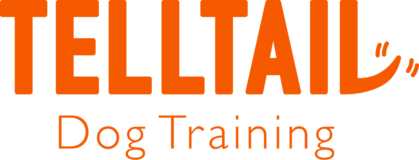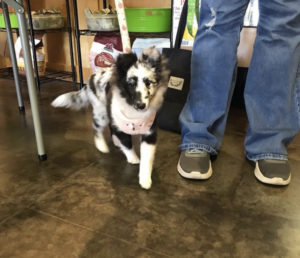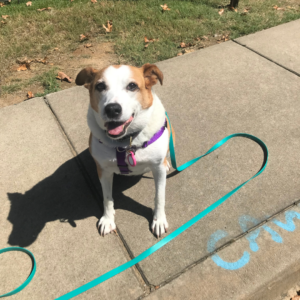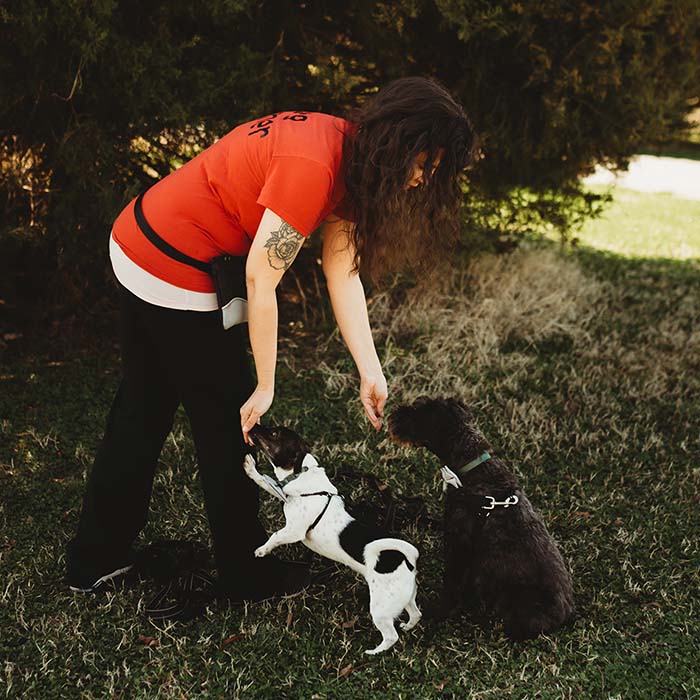How to Train Recall or “Come”
To start training a recall or “come” cue, condition a marker word or a clicker before you add the cue. You should have some indicator of letting your dog know that what they did is correct and a reward is coming.
Then, start with a very short distance in a neutral, low-distraction environment, like in your living room, while your dog is looking at you. Say their name and mark and give them a treat for coming to you.
Consider a special treat you use ONLY for “come”, like hot dogs or deli meat. This should be something special that your dog really loves.
Caution: Avoid dragging your dog to you. Why: This doesn’t help them choose to come to you, and it can poison your presence as a safe person. They should be enthusiastically running to you. You can even work up to them stopping in their tracks to run to you while chasing a squirrel or on a scent, all with positive reinforcement.
Caution: Avoid punishing your dog for running away. Why: They will learn to avoid you, and thus put themselves at risk.
Caution: Avoid making the cue conditional. Why: If you only call your dog to you when you’re leaving the dog park, the backyard, or when the fun ends, then they’ll learn to avoid you. Call them randomly to you (as long as they’re safe), reward them, and let them return to whatever it was that they were doing.
If an emergency happens:
- Stay calm. Try to keep your dog in your line of sight or watch where they went. Have a high value treat ready to go where you can grab it by the front door or in the fridge. Stay with them, but do not run them down or yell. You can try running away from them, using an upbeat, fun voice, or tossing treats at them. Reward them with an entire handful of treats and praise when they come to you and let you touch their collar.
- Do not grab them roughly! This will only condition them to not allow you to touch them next time. Be gentle and condition a collar grab or harness grab BEFORE the emergency.
- If you don’t have food, use the hand signal you practiced. Mine is offering a closed fist, palm forward. My dog can’t see if I have food or not. I can get her, take her home, and give her a lot of rewards. It shouldn’t be the norm you aren’t prepared, but it does happen. Don’t rely on tricking your dog after this, as they’ll lose trust.
Start small and keep things manageable across distance, duration, distraction, and difficulty. Try a long lead. Change the location. There are so many safe ways to practice, which includes a new, fenced location.
Additional Resources
JW Dog Training
Start inside and practice without conditions! Ask your dog to come, reward, and then let them continue as they were. More here:
Build up reliable associations to the word you use:
Practicing alone? Use a long lead and a treat toss or scatter:
Tails of Connection
Additional thoughts on a recall:
Asking your dog to “come” when they’re on a good sniff or super distracted will be a tough ask! Keep distractions low-level to begin with if possible. Tails of Connecton discusses those here:
Kikopup
This video breaks down the very beginning of recall for a puppy or adult dog. This builds up the association of you as a fun person to run to. Notice the click when the puppy begins to run, not at the finish, which is important:
Additional notes on that video: It is mentioned that when training with multiple people, use multiple treats so the treat doesn’t become the cue – the word “come” does!
Want more life-saving cues? See the Drop It article here, and the Leave It article here.




